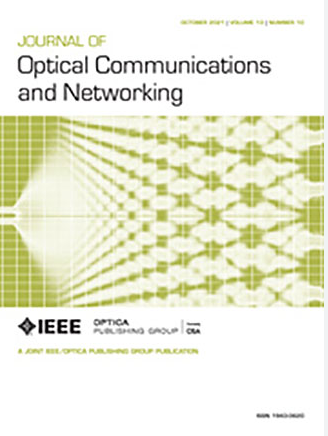Implementation of HetNet architectures based on FSO, VLC, RoF, and photonics-based RF generation toward 6G applications
IF 4
2区 计算机科学
Q1 COMPUTER SCIENCE, HARDWARE & ARCHITECTURE
引用次数: 0
Abstract
This paper presents two distinct network architectures designed to address the demands of 5G/6G applications. The first architecture is an analog radio-over-fiber (RoF) optical fronthaul operating in the V-band at 60 GHz, integrated within a wavelength-division multiplexing passive optical network (WDM-PON). This setup employs photonic techniques for RF signal generation, specifically using carrier-suppressed double sideband (CS-DSB) modulation via Mach–Zehnder modulators (MZMs), enabling efficient frequency multiplication and signal transport. Experimental results demonstrate its ability to achieve a data rate of approximately 11.8 Gbit/s, meeting the requirements for 5G/6G cell densification. The second architecture is a heterogeneous network (HetNet) that combines fiber-wireless (FiWi), free space optics (FSO), and visible light communication (VLC) technologies in a unified network configuration designed for indoor 6G solutions. This HetNet architecture was tested at 39 GHz and features a 20 km optical fiber midhaul, an FSO fronthaul, and a dual VLC/RF access network. The setup was evaluated based on the root mean square error vector magnitude (基于 FSO、VLC、RoF 和基于光子技术的射频生成技术实现面向 6G 应用的 HetNet 架构
本文介绍了两种不同的网络架构,旨在满足 5G/6G 应用的需求。第一种架构是在 60 GHz V 波段运行的模拟光纤上射频 (RoF) 光前端,集成在波分复用无源光网络 (WDM-PON) 中。该装置采用光子技术生成射频信号,特别是通过马赫-泽恩德调制器(MZM)使用载波抑制双边带(CS-DSB)调制,实现了高效的频率倍增和信号传输。实验结果表明,它能够实现约 11.8 Gbit/s 的数据传输速率,满足 5G/6G 蜂窝密集化的要求。第二种架构是异构网络(HetNet),它将光纤-无线(FiWi)、自由空间光学(FSO)和可见光通信(VLC)技术结合在一个统一的网络配置中,专为室内 6G 解决方案而设计。该 HetNet 架构在 39 GHz 频率下进行了测试,具有 20 千米光纤中继、FSO 前端和双 VLC/RF 接入网络。根据均方根误差矢量幅度(${{\rm EVM}_{{\rm RMS}}}$)要求对设置进行了评估,结果表明所采用技术的共存性令人满意,实现了 1.5 Gbit/s 的总数据吞吐量。
本文章由计算机程序翻译,如有差异,请以英文原文为准。
求助全文
约1分钟内获得全文
求助全文
来源期刊
CiteScore
9.40
自引率
16.00%
发文量
104
审稿时长
4 months
期刊介绍:
The scope of the Journal includes advances in the state-of-the-art of optical networking science, technology, and engineering. Both theoretical contributions (including new techniques, concepts, analyses, and economic studies) and practical contributions (including optical networking experiments, prototypes, and new applications) are encouraged. Subareas of interest include the architecture and design of optical networks, optical network survivability and security, software-defined optical networking, elastic optical networks, data and control plane advances, network management related innovation, and optical access networks. Enabling technologies and their applications are suitable topics only if the results are shown to directly impact optical networking beyond simple point-to-point networks.

 求助内容:
求助内容: 应助结果提醒方式:
应助结果提醒方式:


